 We arrived here this year on the last day of the ancient Roman phenomenon known as caniculares , “dog days”. The Romans believed between July 3rd and August 11th, Sirius, the Dog Star, added its own heat to the hot summer, creating some exceptionally high temperatures.
We arrived here this year on the last day of the ancient Roman phenomenon known as caniculares , “dog days”. The Romans believed between July 3rd and August 11th, Sirius, the Dog Star, added its own heat to the hot summer, creating some exceptionally high temperatures.
It was brutally hot here for most of July on up to the day before we arrived, but by the time we got here it cooled down nicely. It was perfect, high 70’s during the days and low 60’s at night. The “dog days” are over and lucky for us, everyone is gone from the city. It’s the holiday of Feragosto (which stems from another Ancient Roman festival). Everyone is at the beach for the annual summer vacation. The city is quiet and all ours. On Sunday morning around 10am, we stood in the middle of the busy Lungotevere along the river and not a car was in sight. Normally this stretch of road is the busiest in the city.
We come to Rome often, walking through the city, visiting museums and ancient monuments and eating our way through the cafes and restaurants. We’ve walked the city through the pages of guide books, through recommendations from friends and with licensed tour guides. We’ve been here in Summer, Winter, Spring and Autumn. We never tire of it.
This time, we decided to see the city through the eyes of scholars; historians, theologians, architects, archeologists and professors. A few years back the association of scholars known as Associazione Culturale Scale Reale reformed into Context Travel. Their courses are many, their guides are intelligent, educated, and highly entertaining. Their ‘tag line’ is ”walking tours for the intellectually curious”, and their 50 or so tours range from art history, to architecture, archaeology, language lessons, drawing, shopping, wine and food tasting and yoga. We signed up for a few of them and they did not disappoint.
What we really discovered through the week of walking tours is that this city is an epic saga of recycled materials and beliefs. Around 126 BC, in the Classical period, the Romans assimilated the Greek ways of life (and their gods) and according the to Romans, made them better. To paraphrase Edgar Allen Poe, it might have been the glory that was Greece, but it was the grandeur that was Rome. The ancient Romans just couldn’t get enough of themselves. Anything you can do I can do better…
Rome conquered and assimilated cultures from the 8th century BC till the 4th century AD. By then, the empire had gotten so large and with so many different cultures, it all got too difficult to control and soon began devouring and assimilating itself. The word “spoils” (booty) comes from the latin word “spolium”. The reflexive Italian verb ‘spogliarsi” means to take something off itself. The “spoglie” (reused elements of Roman buildings) are everywhere we look. It’s hard not to look at a fountain or statue or church or façade of an old Palazzo and wonder which ancient building it came from. One of our docents, a theologian named Christopher Longhurst, explained that the Italians these days use the word spogliarsi to mean dressing up as in accessorizing.
The Romans might have taken religious beliefs, languages and architectural concepts from other cultures but when it came to building, no one was better, or bigger. Their creation of concrete in 175 BC have kept aqueducts, amphitheaters, public baths and temples standing for over 2000 years. Earthquakes have toppled some of them, looters have stolen a lot of their beauty, but they’re still here. Gretchen likes to say, “When the Romans built something, it stayed built.
During his 41year reign, Augustus Caesar changed the face of Rome from brick to marble. Building projects weren’t just for the glory of Rome, they became monuments to the glory of the builder and the more ridiculous the builder, the bigger the building. Monuments to great battles went up all over the city. On the outskirts of the city, along the volcanic “basalt” cobblestones of the Appian Way, wealthy Romans built monuments to themselves. By 312 AD, the monuments along the Appian Way were four deep on both sides of the road.
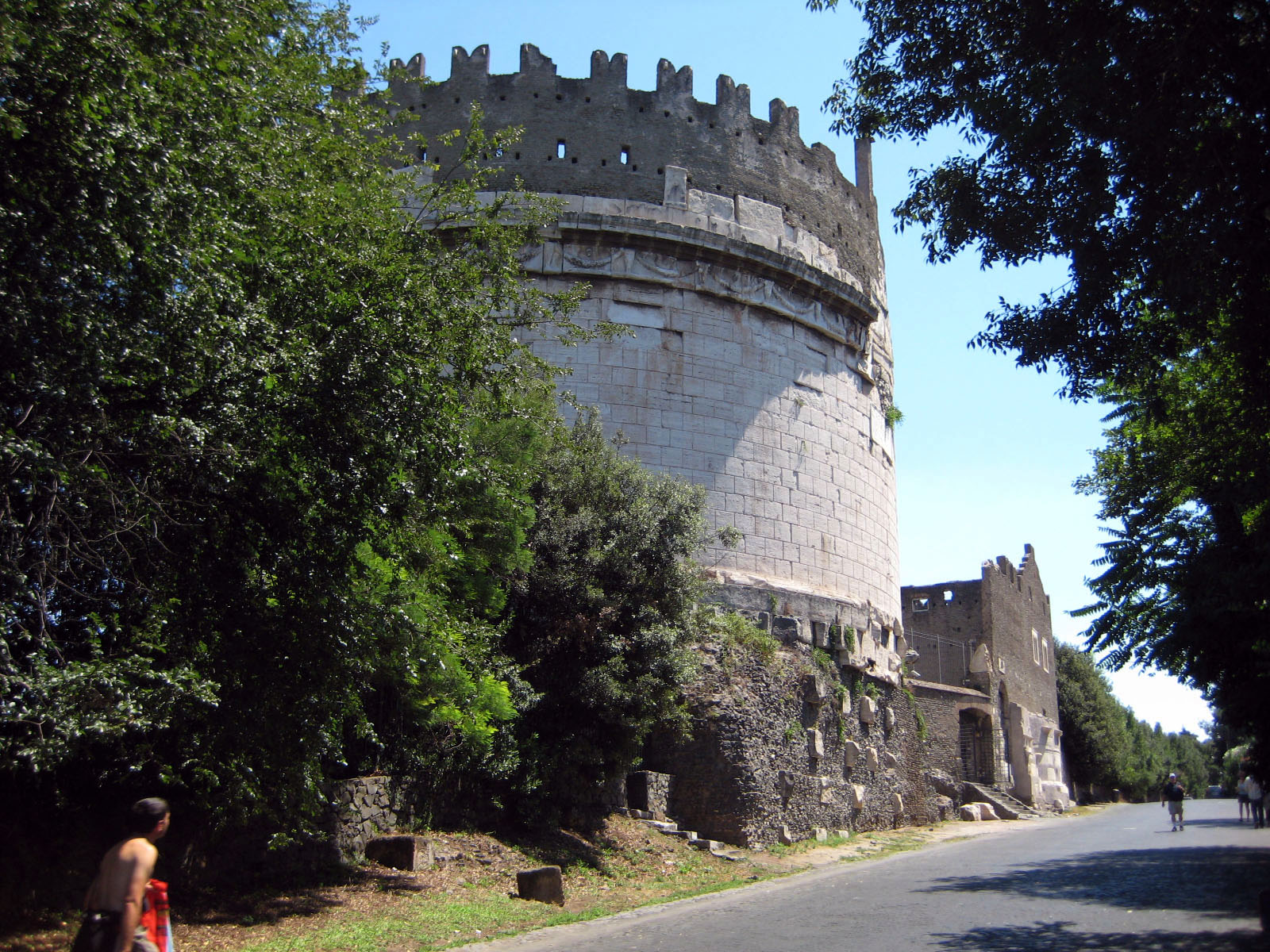 The Roman dictator general Lucius Cornelius Sulla built a massive mausoleum for his wife Caecilia Metella along the Appian Way in 80 BC. She was also the daughter-in-law to Licinius Crassus, the man who defeated Sparticus.
The Roman dictator general Lucius Cornelius Sulla built a massive mausoleum for his wife Caecilia Metella along the Appian Way in 80 BC. She was also the daughter-in-law to Licinius Crassus, the man who defeated Sparticus.
The monument was 36 ft tall and 96 ft in diameter and was most unique because of the frieze of ox skulls that decorated the tomb. It’s one of the few monuments still standing because it was reused as a lookout tower for the Castle of the Caetani family. When the Caetani became a threat to Pope Alexander VI (voted the most decadent Pope in history), he took it and gave to his daughter Lucrezia Borgia. I have no idea what she did with it, but it stayed in the papal collection for years. Most of the stone was given over to Gianlorenzo Bernini or removed and sent to the lime kilns to produce materials for the new baroque city of the 17th century.
Another of the remaining Appian mausoleums is the white travertine marble 12 BC Cestius Pyramid. After Rome conquered Egypt in around 30 BC, everything Egyptian became very fashionable. When wealthy Roman, Caius Cestius bought the location for his massive monument, he decided on the fashionable Pyramid would remind eternity of his greatness for a long time to come. He was right. It’s still there. It was included in the 3rd century Aurelian wall around the city and it’s been a Roman landmark for over 2,000 years.
If a wealthy merchant could build a 27m tall (90’) Pyramid, Emperors had to exceed it by at least 4 times the size. Just check out the Emperor Hadrian’s tomb (now the Castel Sant’Angelo). It’s still one of the most famous building of Rome, ancient and modern. Too bad the tomb of Augustus is gone. When Rome fell in the 5th century, the tomb of Augustus was looted. There were over a 100 members of the Emperors family resting in gold funeral urns. The ashes were all dumped to the ground and the golden urns taken away. As our docent Caroline said, “Can you imagine walking through the cloud of ashes of over 100 of the most famous people of the 1st century?”
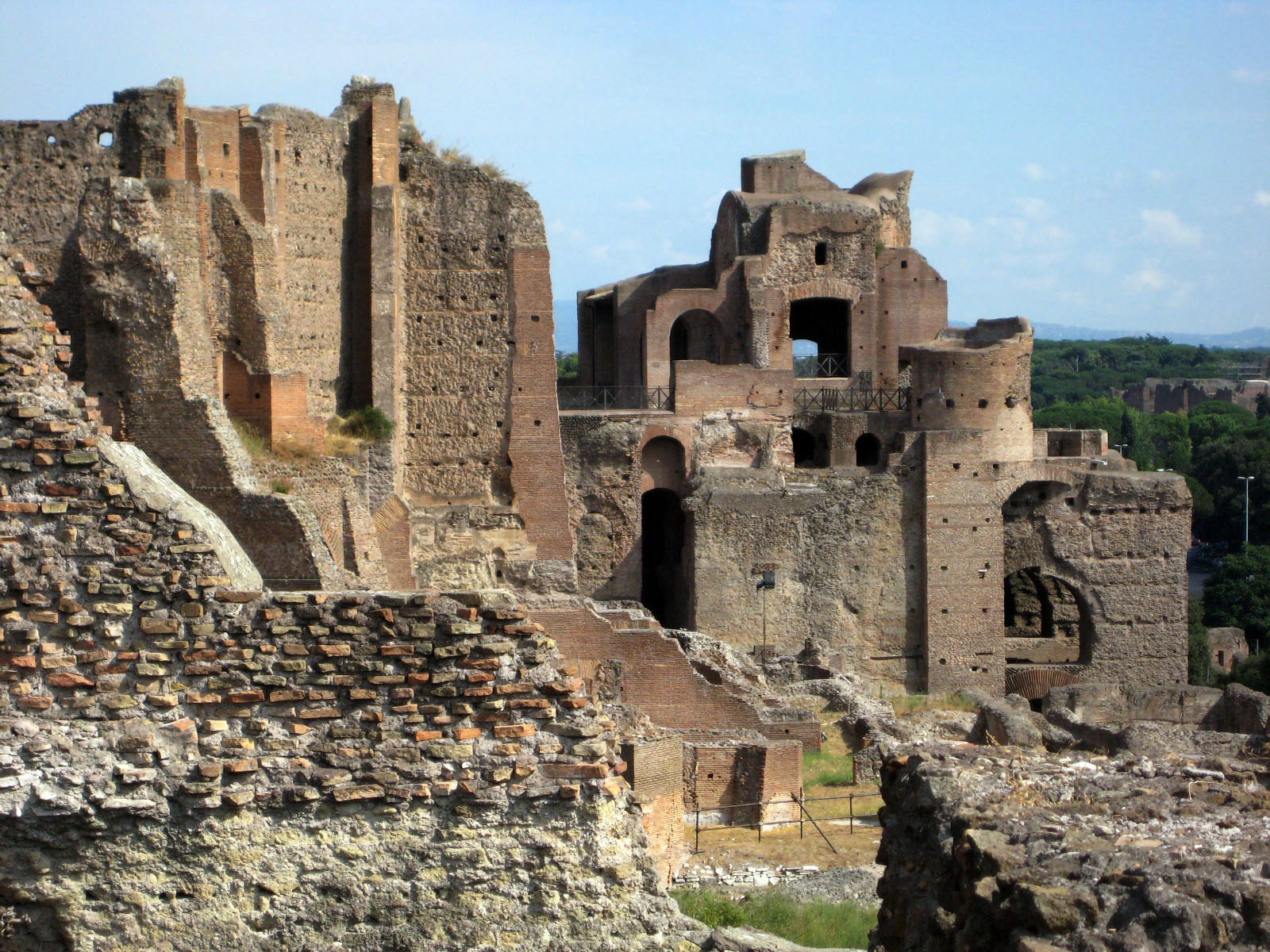 The Palatine Hill was once the “very posh” neighborhood for all the Roman celebrities. In a letter from the Roman Senator Cicero to a friend, he tells him, “I have finally made it. I now have a house on the Palatine.”
The Palatine Hill was once the “very posh” neighborhood for all the Roman celebrities. In a letter from the Roman Senator Cicero to a friend, he tells him, “I have finally made it. I now have a house on the Palatine.”
Augustus built a large villa there during his reign. But then in 92, the very paranoid Emperor Domitian razed everything on the Palatine and built his enormous Domus Flavia (Flavian Palace). The word “Palace” stems from the word Palatine, which became synonymous with Domatia’s imperial complex.
 After Caligula was killed, Emperors got very paranoid. Even the most trusted guards couldn’t really be trusted.
After Caligula was killed, Emperors got very paranoid. Even the most trusted guards couldn’t really be trusted.
Domitian used non-Roman guards, thinking they’d have less reason to align themselves with his enemies in the Senate. Maybe this is why the Popes started using Swiss guards?
Anyway, Domitian was wrong. His enemies got to him anyway, even after he had the marble columns in the Palace so highly polished so he could use them like mirrors to see who was coming. He was killed by the trusted members of his court, just shy of his 45th birthday.
Archaeological digs are still unearthing a lot a new discoveries on the Palatine. The villa of Augustus has been an ongoing discovery site since the 1960’s. In January 2007, Italian archeologist Irene Iacopi announced she might have re-discovered “The Lupercal” beneath Augustus’ Villa. This might have been the cave where Romulus and Remus sucked milk from the female wolf till they were found by Faustulus. Some photos of the re-discovered cave show a decorated vault of seashell mosaics. Of course there are some historians who believe the Luper, or female wolf might have been instead a female prostitute. They both shared the same name, “Luper”. I guess being raised by a she-wolf is a bit more romantic than being raised by a prostitute. History has a way of finding the better retelling of the story.
As far as really big Palaces go, Domatian’s enormous complex was tiny compared to Nero’s Domus Aurea built around 66 AD. (see my post from 2000 on Nero’s Domus Aurea).
Everyone has a favorite emperor of the Roman Empire. Nero is mine. I know he has a bad reputation, although the people of Rome really did love him. It was the Senate that did him in. Maybe he was as evil as his reputation would have us believe, but I find him fascinating. He rigged every sporting competition he entered so he would be the winner. During his famous decadent parties he would bore his guests to tears with 18 hour poetry recitals. One woman pretended to go into labor in order to get out. He tried to kill his mother by rigging the ceiling to fall on her head. When that didn’t work, he tried to poison her. When that didn’t work he killed her with his sword. Finally he just had her assassinated. But as our docent Carlo says, “Hey, he’s appeared in 230 films. That’s a lot more than Julius or Augustus Caesar.”
His pleasure palace, the Domus Aurea, stretched over 3 of the 7 hills of Rome and covered an area larger than the Vatican City. The complex didn’t just include the Palace, there was also the man made lake (later drained to build the Colosseum) and a 120’ bronze statue of himself called the Colossus Neronis. When Nero killed himself (actually his attempt failed so he had his slave finish him off), the face on the Colossus was changed to the sun God, Helios/Sol and moved up the hill. After the lake was drained and the giant stadium was built, the statue was moved again next to the Amphitheatre Flavius (it’s original name). The name Coliseum was attached to the Amphitheater during the middle ages because the Amphitheater was next to the giant statue. We have no idea what happened to the Colossus statue but when the Amphitheater was turned into stone quarry in the late 5th century, it was probably melted down for weapons.
The Coliseum might not be the best preserved Amphitheatre in the world, nor is it the oldest. The one in Pompei is older. But without question it’s the largest and most famous. The base of it covers 6 acres. The exterior wall is estimated to have used over 3.5 million cubic feet of travertine marble. It took 10 years to build it. And what we see today isn’t even the entire building. Part of the exterior and some of the top wall was removed for building materials.
It was built with the money the Emperor Vespatian and his son Titus took from Judea after the squashed the Jewish revolt of 66-68 AD. The Judean treasure included the “Ark of the Covenant”, which traveled to Carthage and Constantinople before being returned back to Jerusalem around 600 AD. Both the Romans and the early Christians thought it was nothing but bad luck. Everywhere it went the owners were defeated. If it is currently buried somewhere in Washington DC, as the writers of Indiana Jones would have us believe, we should get rid of it right away.
The Amphitheatre was a gift to the Romans by the Senate and the Emperor Vespatian. They wanted to give something to the people of Rome that might help to wipe out the memory of Nero. Boy did the Senate hate Nero.
Vespatian went along with the plan even through he was a notorious cheapie. This is the Emperor who served leftovers to his dinner guests saying the food was good enough last night, it should be just as good tonight. He is the same guy who put a tax on public toilets. In fact, Romans still refer to public toilets as vespasiani.
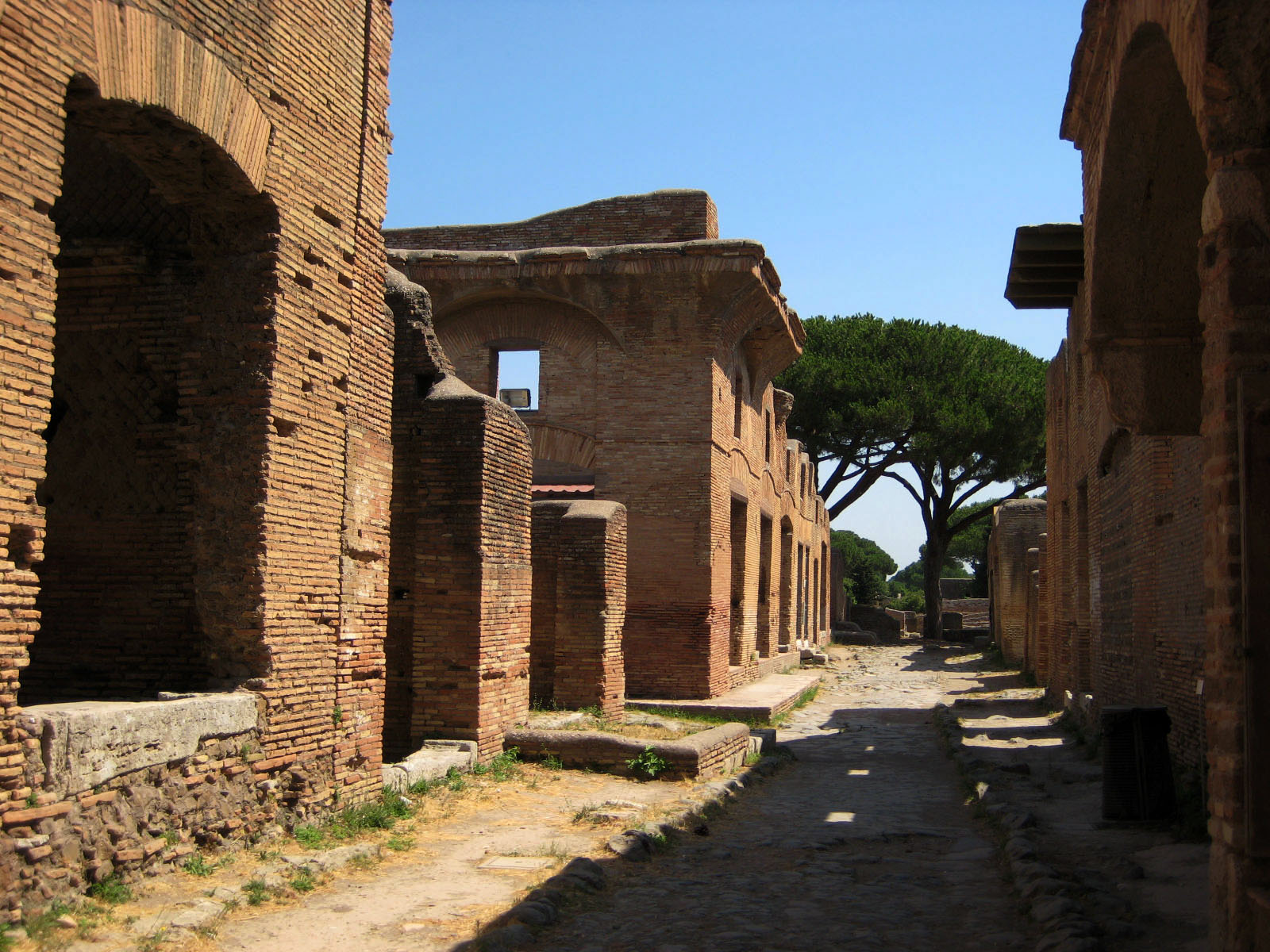 Part of the reason archeological digs keep tuning up more information is that Rome is a city of many levels. After each fire, the rubble was leveled off and new cities were built on top of the old.
Part of the reason archeological digs keep tuning up more information is that Rome is a city of many levels. After each fire, the rubble was leveled off and new cities were built on top of the old.
In our visit to the ancient city of Ostia Antica, a 20 minute metro ride from the Pyramid metro station, our Context decent, Saskia explained that the marsh land of Ostia might have very well been filled with the rubble from the great fire of 64 AD, often called Nero’s fire.
The Roman historian Suetonius thought Nero started the fire so he could claim the land for his Domus Aurea. There are many accounts after the fire started that Roman soldiers threw more wood on the houses to make sure everything burned. But then, there are also accounts of Nero providing food and shelter in his own palace. Suetonius also writes that Nero sang “The Sack of Ilium” in stage costume as the city burned, but another historian, Tacitus, claims the Emperor was in Antioch when the fire broke out. The claims of him playing the lyre while the city burned were probably rumors made up by his enemies in the Senate. The idea of Nero playing the fiddle during the fire is ridiculous since evidence of any bowed string instrument didn’t occur till the 11th century. The violin wasn’t invented till the 16th century.
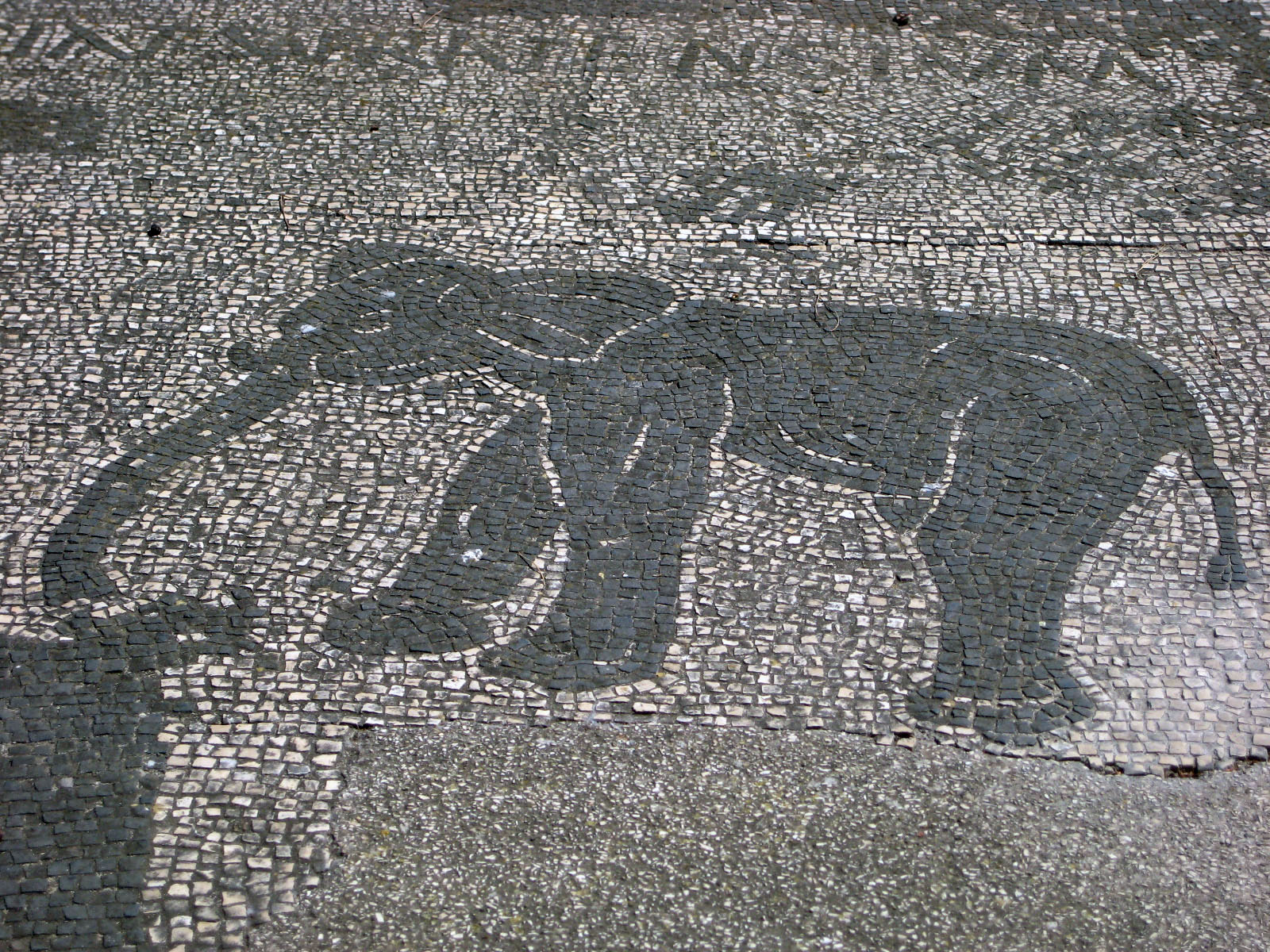
Ostia Antica is a really good look at what a Roman city looked like, complete with merchant houses, insular apartment houses, a theatre, temples, baths, toilets (with plumbing) necropoli (burial tombs) and a really good street layout. This was a merchant city/port where all goods from Egypt, Africa, Spain and other parts of the empire came into Rome.
Shops ranged from exotic animals for the arena games, spices, fish, grain, baths, restaurants, cloth and more. You can still see the shop signs built as mosaics in the floor in front of the merchant doors. You can see one sign from a shopkeeper who imported elephants or another who ran one of the local baths.
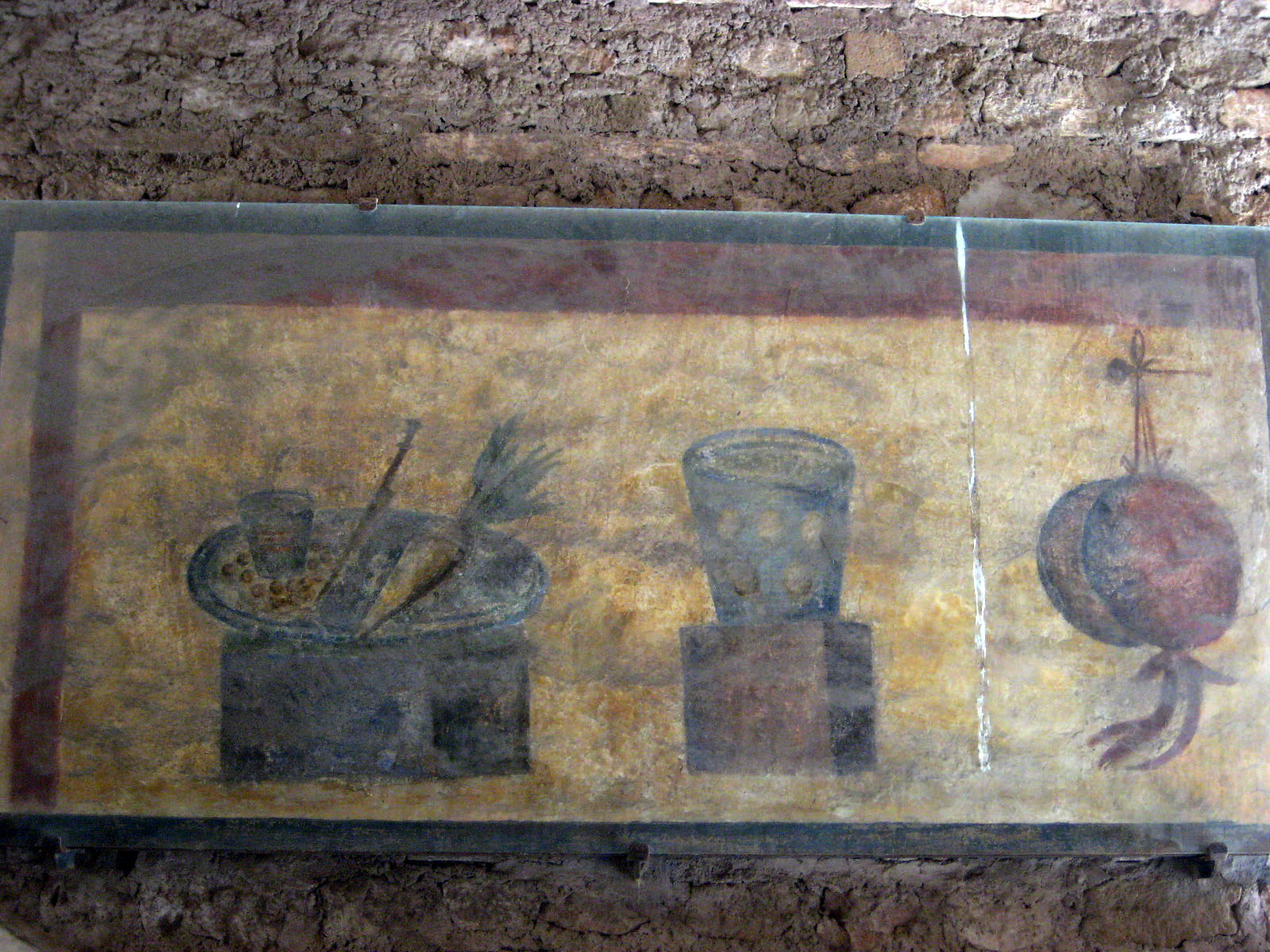
There is even an ancient food menu in one of the local restaurants showing the meal of the day; the main plate of bread with garum,a parsnip and wine, followed by picked eggs, and a pomegranate.
Garum was the main food of these times, a mixture of mashed and fermented fish. A recent dig in turkey found an ampoule that still had some garum inside of it.
In the 2nd century, flooding caused the newer city to be built even higher. These days you can actually see the remains of the first and the second cities. New buildings built over old ones, new arches and gates were raised up to the new level, new lead pipes were laid for plumbing. One theory of the Fall of the Roman Empire was due to lead poisoning from all the lead in the water supply.
It’s also still possible to get down below a few old churches n Rome and see the underground labyrinth of old streets, shops, temples, the remains of early “insular” apartment houses and early Roman life. Under the Church of San Clemente are some remains from the fire of 64 AD.
San Clemente was built over the home of Titus Flavius Clemens who was fed to the lions in the Amphithetre under the rule of Domitian. There are actually three levels of Roman life in this building. It’s one of our favorite places in all of Rome. The lowest includes an old Roman street, a few remains of the “insular” apartments, and a temple and school from the cult of Mithras. The second level has the old 5th century church burned down in a Norman invasion in 1088 and then there is the 12th century church at the top. What a view of history.
Most of the churches in Rome were built over homes of wealthy Romans who converted to Christianity and sheltered the Christians in their homes. The church of Saints Giovanni and Paolo on the Cealian Hill was built over a second century Roman apartment house that was transformed in the 3rd century into the large villa. Giovanni and Paolo, two officers in the court of Constantine were living here when between 361-363, the same time when the Emperor Julian the Apostate re-criminalized Christianity. Bad timing I guess. They were killed and buried in the dwelling and the church was built over their tomb. There are twenty ancient rooms under the church, dating from the 3rd century. The frescos are in great condition. The confessional room is right next to the frescoed nypheaum. How convenient. There is also a great little museum of the artifacts pulled from the dig that opened in 2001.
The church of Santa Cecilia was built above the home of a noble Roman woman who sheltered Christians in her home around 230 AD. She was caught by the Emperor and sentenced to death in her house. The executioner tried to suffocate her in her own overheated bath house, but that didn’t work. The he tried to behead her, but after three tries she was still alive and “supposedly” lived for a few more days. She was placed in the catacombs of St Callisto. The story gets better. Some 800 years later, while excavating the graves, Cecilia’s tomb was opened. There was the body, in perfect shape, no decay. The took the body back to the Church that bears her name in the Trastevere. Cecilia is the patron saint of music.
Most of the Christians who died in the 3rd and 4th centuries were buried in the catacombs along the Appian Way. The Catacombs of Santo Callisto was the only one we visited.
It is estimated that 300,000 Christians were buried here. The guide provided for us by the Church (they want you to be sure to hear the Christian side of the story) said there were 6 levels of tombs. Caroline Barron, our guide from ContextTravel, said there could be as many as 16 levels. The labyrinth of chambers and alleyways were so difficult to follow, it was hard to figure where you were and how to get out. This was why the guide only took us through the first 2 levels. Caroline told us about a new horror film where stupid tourists get lost in an old Christian catacomb and discover pure evil. What fun.
Most people believe the Christians were killed because of their belief in Jesus Christ and monotheism. Not true…The Jews lived in ancient Rome since 161 BC without any problems related to their monotheistic religion. The Romans thought of them as a foreign people with unique beliefs but they posed no threat to Roman life. They even went to Roman temples on festival days and gave tributes to the Roman gods as a gesture of good neighbors.
The Christians, on the other hand were out to convert to Romans. It was one thing to convert a slave or shopkeeper, but once they started influencing wealthy Romans and especially Senators, they were playing with the power balance of the Empire. According to the Emperors, they had gone too far. Tampering with the political balance of the Empire was a crime.
The catacombs started around 205AD when the Christians became a substantial part of the Roman population. Before that, they were buried in large necropolis sites on the outskirts of the city. The most famous Necropolis is the one under St Peter’s Cathedral.
St Peter’s cathedral was actually built near the site of a chariot racetrack built by Caligula and Nero. Peter was thought to be crucified upside down in this circus and buried in the nearby Necropolis. The obelisk in the center of St Peter’s square was the one originally put in the center of the Circus by Caligula. It was moved in the 16th century to its current location.
When Constantine came here in the 4th century he was shown the tomb of St Peter and built an alter over it. As the story goes, he took the bones out of the wall and put them in the wall of the Necropolis for safe keeping. Both of the Basilicas built later followed the plan of Constantine and built the high alter over the “site” of the tomb of St Peter.
In our tour of the excavations, our “Vatican” guide (only Vatican guides are allowed to conduct this tour) tried to explain the whereabouts of the bones to our group, mostly comprised of Christians from the Washington DC area. “Where are the Bones?” they kept on asking. “See the red light against the wall” she told us. “This is where Constantine put the bones”. OK, that kind of made sense until she pointed out a small box in another part of the wall. “Is this the box with the bones?” they asked again. “ We just want to know where the bones are. Please just show us the bones!” I don’t think they ever even looked at any of the other amazing tombs that lined the old necropolis. There are over 100 tombs beneath the basilica, including St Peter, 91 Popes and Christina of Sweden, a celebrity convert who abdicated her throne in 1651 to convert to Christianity. Who knows how many other’s bones are also still there.
The old roman streets and old Christian crypts are pretty impressive and gave us another good insight to early Roman life (and death). The excavation of the St Peter’s necropolis lasted only 10 years. It began in 1939 when the dutiful of the Vatican were burying Pope Pius XI. They always knew the necropolis was there because they knew the tomb of St Peter was there, but when the floor gave way during the burial, Pope Pius XII (the successor) gave the orders to clean out the bones. They’re all gone, buried in some consecrated ground nearby, as if the ground under St Peters wasn’t consecrated enough for them. In 1949 the Vatican became afraid the digging might destroy the foundations of the church (the terra foundations that is). And so that’s all we’ll know. For now…
You need to contact the Vatican Scavi to book a tour in advance. It’s not that expensive, 10 euros per ticket.
I do give a lot of credit to the Church for preserving so much of ancient Rome. It follows the legacy of Rome itself; conquer and assimilate. First they conquered the Roman Empire with Christianity, then, they assimilated the Roman festivals and holidays into Christian festivals and holidays. Then they used the Roman temples and materials to build the new Christian city.
The Roman spring fertility symbols of the egg and rabbit appear at Easter time. The Roman festival of Sol Invictus (the unconquered sun) was on December 25th, the same day as Jesus Christ was born. It was also considered the birth date of the god Mithras (very popular with the military).
In fact, many of the Popes up to at least the 17th century were very similar to many of the Roman Emperors. The stories of excess, debauchery and bribery are unbelievable; putting exhumed bodies of previous Popes on trial, raping female Pilgrims, wild pagan parties. The Medici Pope, Leo X (1513-22) had to resort to pawning the furniture and plates of the papal palace to support his lifestyle. He also made a good income from licensing of all the brothels in Rome. The city of less than fifty thousand had seven thousand registered prostitutes! When Leo X (Medici) made a fortune from selling indulgences (free passes to heaven), it was probably what started Martin Luther’s reformation.
For excess though, none of them come close to Alexander VI (Rodrigo Borgia), who has the dubious distinction as the most excessive Pope in history. His decadence, theft of property, incest, nepotism, adultery and murders and are right up there with Caligula. When he died (he was poisoned), his peers paid their respects by leaving Alexander to rot and turn purple in the Sistine Chapel, until his bloated corpse had to be stuffed and crammed into his coffin.
But as I said, if it wasn’t for the Church, many of the Roman temples would have disappeared to the salvage and “spoglie” looters.
The Franciscan church of Santa Maria in Aracoeli was built on the site of the site of the Juno Moneta temple on the Capitoline Hill, one of the largest temples in all antiquity and also where the money was kept. The word money, comes from “Moneta”. Many of Juno’s old columns were used in the church’s construction. You can still see the reuse of colorful stones in the floor. Porphyry marble, a purple stone reserved for Imperial use only during the time if the Emperors, is everywhere.
Aracoeli (which means the Temple of Heaven) was built in the manner of a Roman Basilica, a large covered with aisles of arcades and colonnades. The Romans used this design (which they stole from the Greeks) for matters of state, judicial halls, tribunals and public functions. The architectural style of the high ceilings and ordered columns created a sense of order and power and worked very well in the judicial halls of ancient Rome, it also worked very well as visual order and power in the Christian churches.
Aracoeli has a few celebrity tombs as well. Helen, mother of Constantine and finder of the “true” cross of Jesus Christ is here under a bizarre 1970’s statue of her carrying a large cross. Many believe that Constantine legalized Christianity in the 4th century only because his mother converted to the religion. Constantine might have built all of the original 4th century churches, but at the same time, he was hedging his bets, building temples to Jupiter and other gods. That’s probably the reason his mother Helen became a Saint and he didn’t.
The tomb of Catherine of Bosnia is also here, the Queen of Bosnia who was convinced by a priest in her last rights in 1460 to give her entire country to the Church. You can imagine how her two sons took that news.
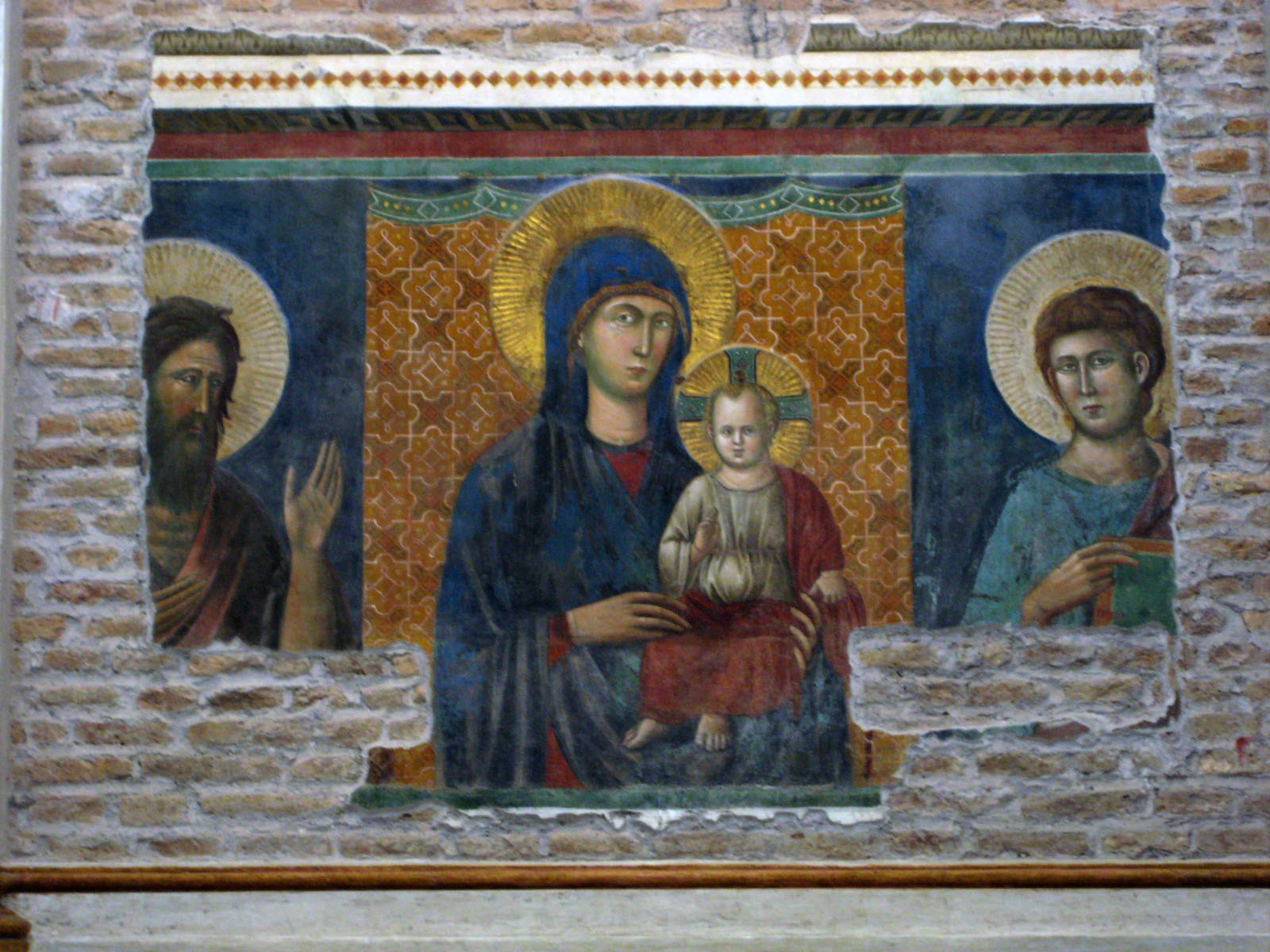 Recently art historians pulled down some of the old frescos in one corner of the church and uncovered an amazing (and complete) 14th century fresco of the Madonna and Child by Pietro Cavallini.
Recently art historians pulled down some of the old frescos in one corner of the church and uncovered an amazing (and complete) 14th century fresco of the Madonna and Child by Pietro Cavallini.
What’s really amazing about this piece, besides being in such good shape) is that the baby Jesus has the appearance of an Emperor giving his approval. Even in the 15th century it was hard to get the Imperial theme out the religion.
But the real treasure of the Aracoeli is the “Santo Bambino” (see 2006 post of Christmas in Rome). Christmas is the big season for the Bambino when they parade him around the church and through the streets. The original Santo Bambino was stolen in 1994 and never returned. But that hasn’t swayed the believers. They still believe this little guy has the same healing powers. He sits in his little glass case covered with jewels and gifts from his thankful and letters from the devoted. There was a stack of letters next to his case while we were there, addressed only to Santo Bambino, Rome, Italy. They find their way.
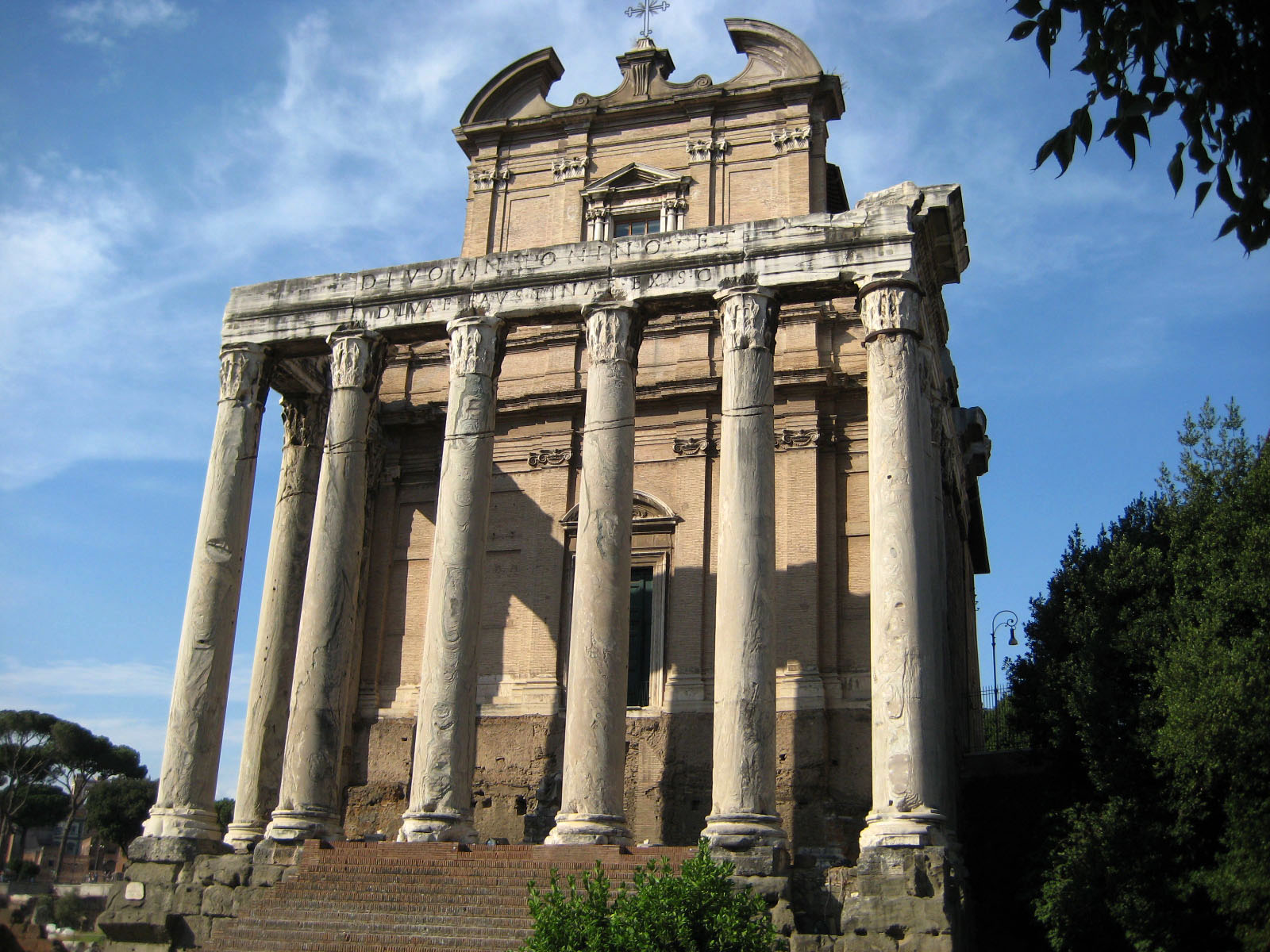 The temple of Emperor Antoninus Pius and his wife Faustina in the Forum was also saved by the Church when it was incorporated into the Church of San Leandro in Miranda.
The temple of Emperor Antoninus Pius and his wife Faustina in the Forum was also saved by the Church when it was incorporated into the Church of San Leandro in Miranda.
In 609, the Pantheon was consecrated as a church. Otherwise it would have ended up as building materials for other buildings. Well, not all of it was saved. Pope Urban VIII (Barberini) ordered the bronze ceiling of the portico to be melted down and reformed into the canons for the fortifications of Castel Sant’Angelo (formerly Emperor Hadrian’s Tomb). Bernini also got some of the bronze the baldachino above the high alter in the basilica of St Peter’s. There is a saying about the looting of ancient Rome: “What the Barbarians didn’t take, the Barberinis did.”
But the looting of Rome wasn’t just limited to the Romans. In the church of Gesu the large solid silver statue of St Ignatius Loyola was melted down by Napolean to pay his soldiers. The replacement looks the same, but it’s not solid silver. However, it is surrounded with very large panels of solid lapis lazuli mined from the mountains of Afghanistan.
At the time the church was built in the early 17th century, lapis lazuli was one of the most precious stones in the world. In the Church of Ignatius Loyola, the sarcophagus of Francis Xavier is made of solid lapis lazuli; very impressive.
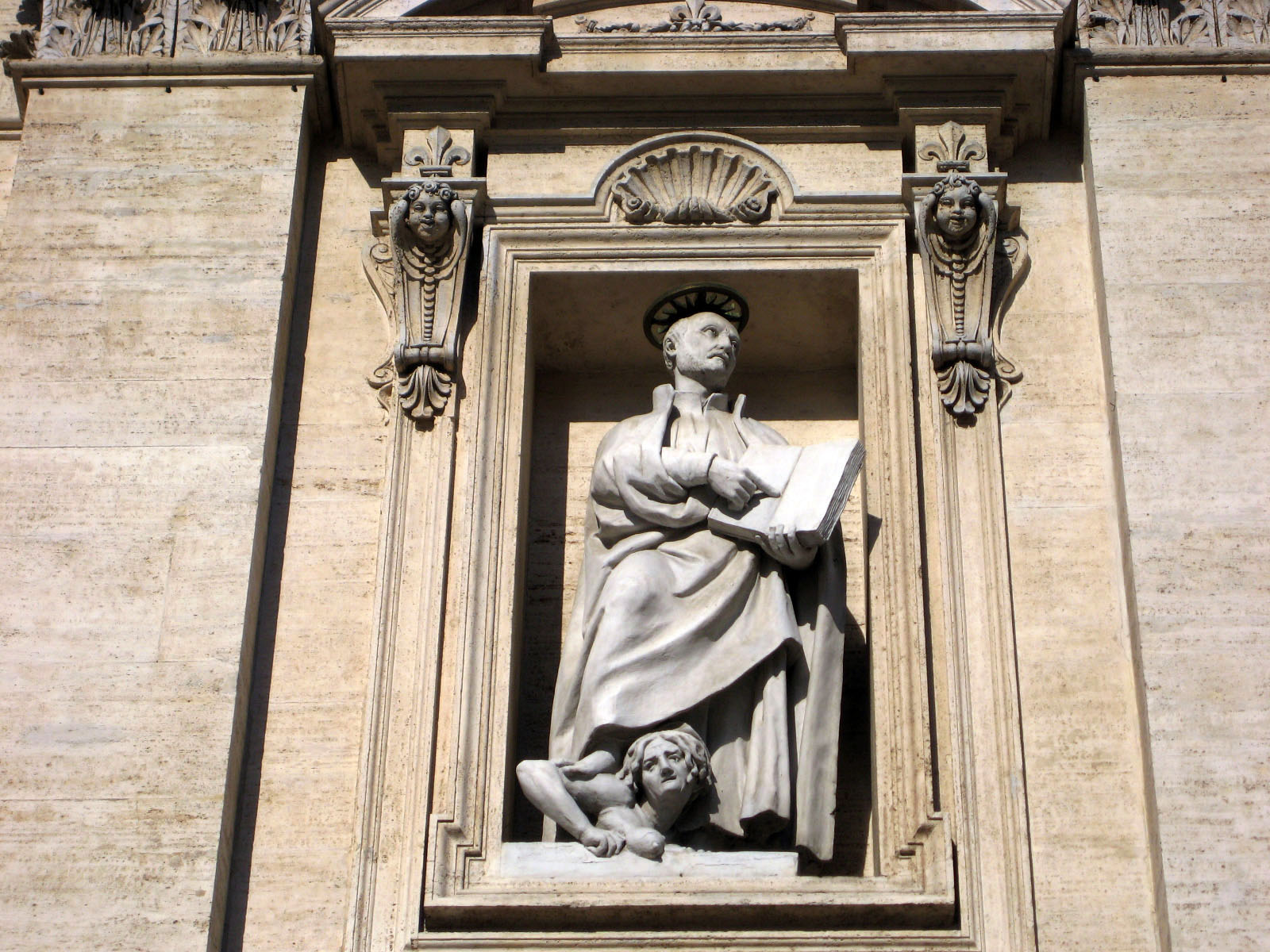 When it comes to the Baroque period of Rome, you just have to sit back and look in awe. There is really no explanation for the display of wealth, except that maybe the Church was trying to impress their power and beauty on the Christians of the world, trying to bring back those who turned to Protestantism and trying to convert new souls. There’s nothing like a shinny bauble to lure the poor. The Catholic Church was powerful and wealthy. The Protestants (or Heretics) were plain and boring. The three credos of the Jesuits were to educate, convert and fight the heretics. It took a lot of wealth to accomplish all three. The statues on the outside of the Gesu Church of Rome show St Ignatius stepping on the body of an old ugly woman representing the heretics. In my opinion, this is totally unfair to ugly old women everywhere.
When it comes to the Baroque period of Rome, you just have to sit back and look in awe. There is really no explanation for the display of wealth, except that maybe the Church was trying to impress their power and beauty on the Christians of the world, trying to bring back those who turned to Protestantism and trying to convert new souls. There’s nothing like a shinny bauble to lure the poor. The Catholic Church was powerful and wealthy. The Protestants (or Heretics) were plain and boring. The three credos of the Jesuits were to educate, convert and fight the heretics. It took a lot of wealth to accomplish all three. The statues on the outside of the Gesu Church of Rome show St Ignatius stepping on the body of an old ugly woman representing the heretics. In my opinion, this is totally unfair to ugly old women everywhere.
In the 2nd century there were close to 1.2 million people in Rome. By the 6th century there were barely 30,000. In 37 AD, there were 170 public baths in the city. We have sport clubs with swimming pools, gyms and saunas and massage rooms but in any given city of a million people there aren’t 170 Sport Clubs. And none of the ones that do exist today can even come close to the Caracalla Baths..
Between 212-216 AD, Emperor Caracalla built the largest bath complex known to Rome. Caracalla was mostly known for killing his brother, naming his mother as a ruling power and for being murdered by his own guards while he was relieving himself.
 His legacy, however, is the Baths of Caracalla. It still covers 33 acres. The bath building alone was 750 ft long, 380 ft wide and over 99’ tall. Over 1,600 people a day would come to bathe.
His legacy, however, is the Baths of Caracalla. It still covers 33 acres. The bath building alone was 750 ft long, 380 ft wide and over 99’ tall. Over 1,600 people a day would come to bathe.
Our docent, Carolyn, explained to us that it took over 10 tons of wood to heat the caldariums (hot rooms) alone. When the baths first opened, many of the slaves suffocated in the furnace room from throwing so much wood into the heaters. By the way, being a slave in Rome wasn’t as bad as you think, unless you were put on work detail throwing firewood into the bath furnaces. All slaves were educated to read and write and after 3 years they were given their freedom and became Roman citizens, usually with a nice gift from their former owner.
The Roman workday started at sunrise and ended around 2pm. After that, it was Bath Time. Everyone was welcome, rich and poor. Yes, some wealthy Romans did have their own baths in their homes but they liked coming to the large baths to mingle with the public; and let’s face it, the Caracalla baths were probably a lot more grandioso than their own.
The afternoon started with a workout in the Palestra, then, their skin was scraped and exfoliated and they’d lie in a cool room for a while. After an oil rub and a warm bath, they’d relax or have a swim in the 164’x82′ (Olympic size) swimming pool before going back into one of the hot rooms. They’d finish off the day with a nice cold visit to the frigadarium. But the baths weren’t just for exercise and corporal pleasure.There were also 2 large libraries where the citizens could exercise their minds as well; one in Latin and one in Greek. All residents of the Roman Empire (including slaves) were taught to read and write both in Latin and Greek. Latin was the common language, the language of the streets, but Greek was the formal language. They had schools, medical coverage, social benefits, entertainment, all paid for by the government. Life was not so bad.
In the 5th century, the Visigoth General Yisigines destroyed the acqueduct that fed the Caracalla baths and they closed down. By the 12th century, the Romans began using the baths as a quarry for materials and by the 16th century most everything was pulled out. The Church of Santa Maria in Trastevere (a very beautiful church and the oldest in the city) was built with a lot of the columns from the Caracalla baths.
 But as big as these baths might have been, the Baths of Diocletian were twice the size and accommodated twice the number of people. You can still see remains. They currently take up most of the area around the Piazza della Republica and the Termini (Rome train station). And that’s just the part we can still see. The Caracalla baths are more complete because they were built on the other side of the Circus Maximus, a more remote area. Diocletian, unfortunately, built his baths in the middle of the city. This was great for the convenience of bath, but once the city started rebuilding itself, the baths had to go.
But as big as these baths might have been, the Baths of Diocletian were twice the size and accommodated twice the number of people. You can still see remains. They currently take up most of the area around the Piazza della Republica and the Termini (Rome train station). And that’s just the part we can still see. The Caracalla baths are more complete because they were built on the other side of the Circus Maximus, a more remote area. Diocletian, unfortunately, built his baths in the middle of the city. This was great for the convenience of bath, but once the city started rebuilding itself, the baths had to go.
The entrance to the Basilica of Santa Maria degli Angeli e dei Martiri was part of the round tepidarium (heated room) of the Diocletian Baths. When Michaelangelo designed this church he wanted to pay homage to the ancients and kept most of the ancient bath in place, including the soaring ceilings and intersecting arches and many of the Diocletian columns. The center of the large Church is the expanse that once was the frigidarium (cool water swimming pool). It’s really exciting to see it.
By the 17th century, Rome had taken on a whole new look. The old parts and pieces were still there but put in different places or incorporated into different buildings.
 Between 1585-1590 Pope Sixtus V took some of the old obelisks brought back from Egypt between 10BC and the 4th century and used them to mark four corners important to his view of the city. They still show the way to the church of Santa Maria Maggiore, the Spanish Steps, the church of St John in Laterano and the Quirinale palace.
Between 1585-1590 Pope Sixtus V took some of the old obelisks brought back from Egypt between 10BC and the 4th century and used them to mark four corners important to his view of the city. They still show the way to the church of Santa Maria Maggiore, the Spanish Steps, the church of St John in Laterano and the Quirinale palace.
The plagues of the 15th and 16th centuries devastated western Europe. I really believe that even though the same amount of wealth was still there, there were 30% less people, and without the extra people to support, rich people got a lot richer.
The Renaissance was kind of a coming out party from the gloom and doom of the Black Plague. As more money got put into the arts, the art changed. New and more expensive materials became available, new ideas became in fashion, larger projects were commissioned; sounds a lot like Rome in the 1st century, doesn’t it.
By the 17th century, Baroque Rome was in full bloom.
When the Barberini Pope Urban VII was throwing money at projects all over the city, he also decided to spruce up his own villa as well and hired two 20 year old architects and sculptors to enlarge it for him. This was the first, and quite possibly the only time Giovanni Lorenzo Bernini and Francesco Borromini ever worked together. They spent most of their lives as enemies and competitors.
Giovanni Lorenzo Bernini, the son of a sculptor became a famous the most famous sculptor of Baroque Rome. He was an artist, flamboyant egoist and the life of the party before he was even 20 years old. Wherever he went, people lined the streets to see him, a true celebrity. His ability to pull emotion from stone is still legendary. The expression of Santa Teresa in the Santa Maria della Vittoria church is almost sexual ecstasy. Or just take a look at how the flesh of Proserpina gives way to the grip of Pluto as he kidnaps her and brings her off to Hades. This great piece and other amazing Bernini statues are all in the Borghese Museum. A trip to Rome is not complete without seeing the mastery of Bernini.
Francesco Borromini, on the other hand, was the son of a stone mason, lacked social graces, and after many bouts of depression and killed himself less than 2 months before his 68th birthday. Bernini and Borromini were born about a year a part.
If you want to get a good understanding of the difference between these two amazing artists make a visit to the Borromini church of San Carlo alle Quattro Fontane and then the Bernini masterpiece of the Sant’Andrea al Quirinale a few doors away.
Borromini’s San Carlo is elegant and simple geometric shapes and plaster figures. The curves of the room create movement and flow. While Bernini’s Sant’Andrea is filled with marble cherubs and a large statue of Saint Andrew in his crucified position. The ceiling is golden, washed through gold covered glass. The walls are covered with pink and white marble. Our docent, Liz, told us that Bernini took the job for no pay in exchange for total artistic control. It’s classic baroque, as ornate as you can get, while Borromini’s church was built for a poor Spanish order who barely had enough money to pay for the church and the project was constantly put on hold. It’s most likely that they were looking in on each other’s work. They were working too close to each other not to.
These days the Barberini Palace has been turned into a Fine arts museum. There are a few Caravaggio paintings (another of the great masters of Roman Baroque), and a Rafael portrait of La Fornarina, (bakeress) Margherita Luti, supposedly the true love of Rafael. Her left arm has a narrow band carrying the signature of the artist, RAPHAEL URBINAS, kind of like a tattoo reading “property of Rafael”.
According to the 16th century painter and art historian, Giorgio Vasari, Rafael’s premature death on Good Friday (April 6, 1520, his 37th birthday) was caused by a night of excessive sex and drinking which caused him to succumb into a fever. He couldn’t tell the doctor what caused the fever and was consequently given the wrong cure, which killed him. After his death, Margherita joined a convent. The portrait appeared many years later. I’m still not clear as to whether Rafael fever was caused by a night with Margherita Luti or someone else.
By the end of the 17th century, the ruins of ancient Rome became so romantic (a word that stems from the word Rome), that people started building fake ruins. Either there weren’t any good spoglie left in the city or it was just easier to create them. The Roman ruins in the Borghese gardens are all reproductions. There are probably a lot more as well. It’s pretty strange.
The influence of ancient Rome on architecture is all around us. The Jefferson Memorial in Washington, D.C., is taken from the Pantheon, so are a lot of the buildings Jefferson designed during his life. The original interiors of Grand Central and Penn Station in New York were modeled on the Baths of Caracalla. I’m sure there are hundreds more examples like these.
Last night at 10pm, a fire broke out at the Cinecitta studios, a couple of miles from here. The set of the HBO “Rome” series was destroyed, something reminiscent of the many great fires that changed the face of this Ancient city. We had hope of a continuation of the Rome series. Although HBO ended Rome after 2 seasons, the studio was hoping to re-use the sets for other productions. Maybe they’ll use the rubble as a foundation to build a new set. That would certainly be the historical thing to do.
You must be logged in to post a comment.